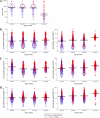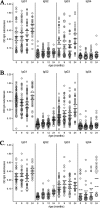Age-dependent IgG subclass responses to Plasmodium falciparum EBA-175 are differentially associated with incidence of malaria in Mozambican children
- PMID: 22169088
- PMCID: PMC3272921
- DOI: 10.1128/CVI.05523-11
Age-dependent IgG subclass responses to Plasmodium falciparum EBA-175 are differentially associated with incidence of malaria in Mozambican children
Abstract
Plasmodium falciparum blood-stage antigens such as merozoite surface protein 1 (MSP-1), apical membrane antigen 1 (AMA-1), and the 175-kDa erythrocyte binding antigen (EBA-175) are considered important targets of naturally acquired immunity to malaria. However, it is not clear whether antibodies to these antigens are effectors in protection against clinical disease or mere markers of exposure. In the context of a randomized, placebo-controlled trial of intermittent preventive treatment in infants conducted between 2002 and 2004, antibody responses to Plasmodium falciparum blood-stage antigens in a cohort of 302 Mozambican children were evaluated by immunofluorescence antibody test and enzyme-linked immunosorbent assay at 5, 9, 12, and 24 months of age. We found that IgG subclass responses to EBA-175 were differentially associated with the incidence of malaria in the follow-up period. A double amount of cytophilic IgG1 or IgG3 was associated with a significant decrease in the incidence of malaria (incidence rate ratio [IRR] = 0.49, 95% confidence interval [CI] = 0.25 to 0.97, and P = 0.026 and IRR = 0.44, CI = 0.19 to 0.98, and P = 0.037, respectively), while a double amount of noncytophilic IgG4 was significantly correlated with an increased incidence of malaria (IRR = 3.07, CI = 1.08 to 8.78, P = 0.020). No significant associations between antibodies to the 19-kDa fragment of MSP-1 (MSP-1(19)) or AMA-1 and incidence of malaria were found. Age, previous episodes of malaria, present infection, and neighborhood of residence were the main factors influencing levels of antibodies to all merozoite antigens. Deeper understanding of the acquisition of antibodies against vaccine target antigens in early infancy is crucial for the rational development and deployment of malaria control tools in this vulnerable population.
Figures



Similar articles
-
Immunoglobulin G subclass-specific responses against Plasmodium falciparum merozoite antigens are associated with control of parasitemia and protection from symptomatic illness.Infect Immun. 2009 Mar;77(3):1165-74. doi: 10.1128/IAI.01129-08. Epub 2009 Jan 12. Infect Immun. 2009. PMID: 19139189 Free PMC article.
-
Impact of age of first exposure to Plasmodium falciparum on antibody responses to malaria in children: a randomized, controlled trial in Mozambique.Malar J. 2014 Mar 27;13:121. doi: 10.1186/1475-2875-13-121. Malar J. 2014. PMID: 24674654 Free PMC article. Clinical Trial.
-
Antibodies to Plasmodium falciparum erythrocyte-binding antigen-175 are associated with protection from clinical malaria.Pediatr Infect Dis J. 2011 Dec;30(12):1037-42. doi: 10.1097/INF.0b013e31822d1451. Pediatr Infect Dis J. 2011. PMID: 21817955 Free PMC article.
-
The relationship between anti-merozoite antibodies and incidence of Plasmodium falciparum malaria: A systematic review and meta-analysis.PLoS Med. 2010 Jan 19;7(1):e1000218. doi: 10.1371/journal.pmed.1000218. PLoS Med. 2010. PMID: 20098724 Free PMC article. Review.
-
Antibody Correlates of Protection from Clinical Plasmodium falciparum Malaria in an Area of Low and Unstable Malaria Transmission.Am J Trop Med Hyg. 2020 Dec;103(6):2174-2182. doi: 10.4269/ajtmh.18-0805. Epub 2020 Oct 27. Am J Trop Med Hyg. 2020. PMID: 33124533 Free PMC article. Review.
Cited by
-
Erythrocyte-binding antigens of Plasmodium falciparum are targets of human inhibitory antibodies and function to evade naturally acquired immunity.J Immunol. 2013 Jul 15;191(2):785-94. doi: 10.4049/jimmunol.1300444. Epub 2013 Jun 17. J Immunol. 2013. PMID: 23776178 Free PMC article.
-
An evolutionary approach to identify potentially protective B cell epitopes involved in naturally acquired immunity to malaria and the role of EBA-175 in protection amongst denizens of Bolifamba, Cameroon.Malar J. 2016 May 20;15(1):281. doi: 10.1186/s12936-016-1337-z. Malar J. 2016. PMID: 27207101 Free PMC article.
-
Homologous but not heterologous COVID-19 vaccine booster elicits IgG4+ B-cells and enhanced Omicron subvariant binding.NPJ Vaccines. 2024 Jul 17;9(1):129. doi: 10.1038/s41541-024-00919-8. NPJ Vaccines. 2024. PMID: 39013889 Free PMC article.
-
A prospective cohort study to assess the micro-epidemiology of Plasmodium falciparum clinical malaria in Ilha Josina Machel (Manhiça, Mozambique).Malar J. 2016 Aug 31;15(1):444. doi: 10.1186/s12936-016-1496-y. Malar J. 2016. PMID: 27577880 Free PMC article.
-
Baseline exposure, antibody subclass, and hepatitis B response differentially affect malaria protective immunity following RTS,S/AS01E vaccination in African children.BMC Med. 2018 Oct 31;16(1):197. doi: 10.1186/s12916-018-1186-4. BMC Med. 2018. PMID: 30376866 Free PMC article. Clinical Trial.
References
-
- Alonso PL, et al. 2004. Efficacy of the RTS,S/AS02A vaccine against Plasmodium falciparum infection and disease in young African children: randomised controlled trial. Lancet 364:1411–1420 - PubMed
-
- Alonso PL, et al. 2002. Manhiça DSS, Mozambique, p 189–195 In INDEPTH (ed), Population and health in developing countries. Population, health, and survival at INDEPTH sites, 1st ed, vol 1 International Development Research Centre (IDRC), Ottawa, Ontario, Canada
-
- Alonso PL, et al. 1994. Randomised trial of efficacy of SPf66 vaccine against Plasmodium falciparum malaria in children in southern Tanzania. Lancet 344:1175–1181 - PubMed
Publication types
MeSH terms
Substances
LinkOut - more resources
Full Text Sources
Research Materials

